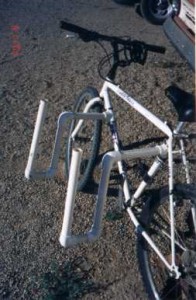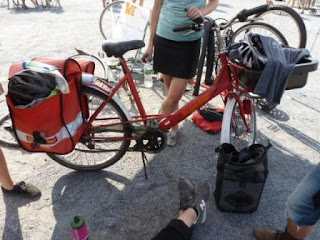The past few days are the longest I've gone without posting in quite some time. Part of the reason for that is that the semester started this week. And, at the same time, I found myself teaching French to an FBI agent. That's a story--a happy one--unto itself!
Today I finally got out for a ride. It wasn't very long, by my standards: to Rockaway Beach. It seems that every year I see more surfers there. And, for about the past year or two, I've seen surfers ride bicycles to the beach.
What that means is that more surfers are carrying their boards on their bikes. I have never done anything like that myself, so perhaps it;s not surprising that, until recently, I couldn't understand how one would. I suppose that if I'd spent more time in, say, California or Hawaii, I'd have a better idea of how such things done. Can you imagine what Dutch cyclists would come up with if more of them surfed?
I've seen a few bikes with "sidecars" for their 'boards:
This setup reminds me of what a fisherman rigged to his bike so he could carry his poles, buckets and other gear:
Clever as those setups are, I don't think either of them has anything on the way this board is hooked up to its bike:
All of these 'maritime mules are homemade or made by very small operations. I wonder whether there'enough of a market for Burley or some other manufacturer of bicycle trailers to consider making them.
Or...I could just imagine what the Cannondale Bugger might have looked like had it been designed by surfers!
Today I finally got out for a ride. It wasn't very long, by my standards: to Rockaway Beach. It seems that every year I see more surfers there. And, for about the past year or two, I've seen surfers ride bicycles to the beach.
What that means is that more surfers are carrying their boards on their bikes. I have never done anything like that myself, so perhaps it;s not surprising that, until recently, I couldn't understand how one would. I suppose that if I'd spent more time in, say, California or Hawaii, I'd have a better idea of how such things done. Can you imagine what Dutch cyclists would come up with if more of them surfed?
I've seen a few bikes with "sidecars" for their 'boards:
This setup reminds me of what a fisherman rigged to his bike so he could carry his poles, buckets and other gear:
Clever as those setups are, I don't think either of them has anything on the way this board is hooked up to its bike:
 |
| From The Surfing Blog |
All of these 'maritime mules are homemade or made by very small operations. I wonder whether there'enough of a market for Burley or some other manufacturer of bicycle trailers to consider making them.
Or...I could just imagine what the Cannondale Bugger might have looked like had it been designed by surfers!
 |
| Original Cannondale "Bugger," circa 1972 |





















